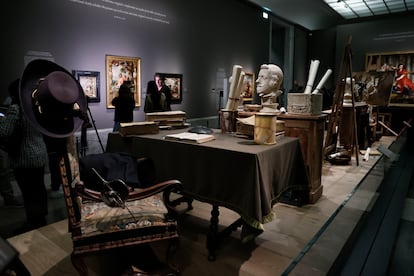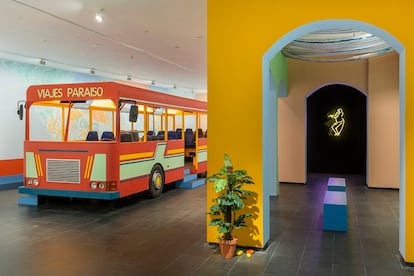With the change of year new art exhibitions also arrive in Spain. But before turning the page, the first months of 2025 offer the opportunity to say goodbye to some of the most relevant exhibitions of 2024. This is a selection of exhibitions that opened last year that will close their doors between January and February.
Sol Calero. I’m looking for soursopsCA2M Museum
After her time at the Venice Biennale and Art Basel, the Venezuelan artist Sol Calero (Caracas, 43 years old) — who has lived in Europe for 17 years — settles in Madrid to parody the Western image regarding the Latin and the Caribbean. . It does so through murals, sculptures and paintings that refer to tropical aesthetics, and that seek to recreate the migrant experience, questioning the cultural stereotypes of Latin America in Europe. The exhibition curated by Tania Pardo, chosen as one of the 10 best of last year by the experts at , is the first individual exhibition dedicated to the artist in a Madrid institution, and brings together some of the main characteristics of her work that has triumphed in the world. Until this Sunday, January 5th.
31 women. A Peggy Guggenheim exhibitionMapfre Foundation
Peggy Guggenheim (1898-1979) had one of the most important collections of modern art in the world. In his gallery The Art of This Century, opened in New York in 1942, some of the most relevant artists of the time exhibited, such as Georges Braque, Victor Brauner, Pablo Picasso, Salvador Dalí and Max Ernst. In those same walls, the famous art dealer inaugurated, in 1943, the exhibition Exhibition by 31 women (Exhibition by 31 Women), one of the first exhibitions in the United States that exclusively exhibited works by female artists—mainly linked to surrealism and abstraction. Painters like Frida Kahlo, Leonora Carrington and Dorothea Tanning were there. The Mapfre Foundation, at its Madrid headquarters, presents a selection and reinterpretation of that initiative, including all the protagonists of that time, in an exhibition curated by Patricia Mayayo. Until this Sunday, January 5th.

Saul Steinberg, artistaJuan March Foundation
Saul Steinberg (1914-1999) was known, mainly, for the illustrations and vignettes—more than 87 covers and 300 drawings—that occupied the pages of the magazine for more than half a century. The New Yorker. But in addition to his work on paper, he also did collages, paintings, prints, murals and photographs. His enormous artistic production can be seen, with more than 400 pieces, in this exhibition at the foundation’s Madrid headquarters, curated by Alicia Chillida. An exhibition that aims, through a linear journey of his life and work, to show the illustrator with the category that perhaps his close relationship with printed paper has diluted: that of artist. Until January 12.
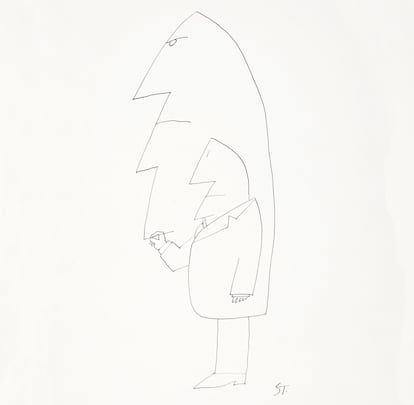
Henri Cartier-Bresson. Watch!, watch!, watch!KBr photography center
Henri Cartier-Bresson (1908-2004) began photographing, with a small 35 mm Leica camera, in 1931. Since then he witnessed some of the most relevant events of the 20th century. Wars, revolutions, artists, intellectuals and street people passed through his lens. Images that focus on the human condition, but are also presented as rigorous compositions in their own right. 20 years after his death, the KBr photography center in Barcelona remembers him with an exhibition – organized by the Mapfre Foundation and the Bucerius Kunst Forum – of 240 images, all original copies – Cartier-Bresson stipulated that they would not be printed again after of his death—which represents a journey through the 20th century: from the Spain of the Republic to New York in the seventies. With his photographs and with his own concept which he called the decisive moment —that fraction of a second that reveals the broader truth of a situation—shaped modern photography and made photojournalism a primary source of information. Until January 26.
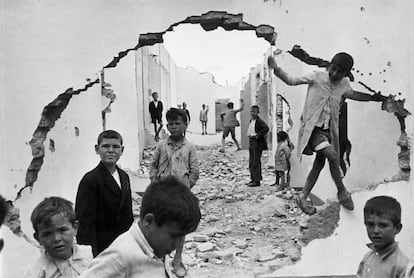
Hilma of KlintMuseo Guggenheim Bilbao
To talk about abstraction is to talk about Kandinsky, Mondrian or Pollock. Until not many years ago, the name of Hilma af Klint (1862-1944) joined that list. Especially after a six-month exhibition at the Guggenheim Museum in New York in 2018, which made her—with more than 600,000 visitors—the unexpected star of that year’s artistic calendar. Now, more than eight decades after her death, the Swedish artist is considered a pioneer of abstract art—she began making non-figurative compositions years before Kandinsky or Mondrian. Your project paintings for the temple, A series of large-format works, full of color and geometric shapes, that deviated from the known representations of the time, was perhaps the most important of his unknown career. The artist, who already sensed that she was ahead of her time, made it clear before she died that her work should not be exhibited until twenty years after her death when, she said, the world was ready to understand it. The Guggenheim Museum Bilbao presents her paintings, away from the public for almost half a century – they were shown for the first time in 1986 – with their author already converted into a reference in the history of art. Until February 2.
Art in stoneLa Pedrera
It is the stone that is the protagonist of the evolution of modern sculpture. At the beginning of the 20th century, several sculptors returned to direct stone carving, without making clay or plaster models. This exhibition, curated by Penelope Curtis, inside Casa Milà—commonly known as La Pedrera—, Gaudí’s work on Passeig de Gracia in Barcelona, brings together the work—more than 80 pieces in total—of eight of the sculptors. most important people who worked with stone at the end of the 19th century and beginning of the 20th century: Hans Arp, Louise Bourgeois, Eduardo Chillida, Naum Gabo, Barbara Hepworth, Henry Moore, Isamu Noguchi and Jorge Oteiza. The sculptures are accompanied by photographs of the artists working in their workshops and other large format photographs by the photographer Aglaia Konrad, from the Carrara quarries. A tribute to the stone and those who have worked with it. Until February 2.

Catalonia La Pedrera Foundation
Santiago Sierra. 1502 people facing the wallCA2M Museum
The works of the artist Santiago Sierra (Madrid, 59 years old) frequently arouse controversy. From his series Political prisonerswhich portrayed Catalan independentists, and which was removed from Arco in 2018, filling the pages of national and international media, even its ninot of King Felipe VI which, at the same fair, ended up burning for not finding a buyer. Now, starring indigenous people, abused women, addicts, war veterans and migrants—all of them with their backs turned—the photographs of the Madrid native who has produced work in 73 countries and has exhibited in art centers around the world, dress the walls of the CA2M from Móstoles, in an exhibition curated by Alexis Callado, Sierra’s first in a Madrid center, and which reflects on the themes that its protagonists embody. Until February 2.
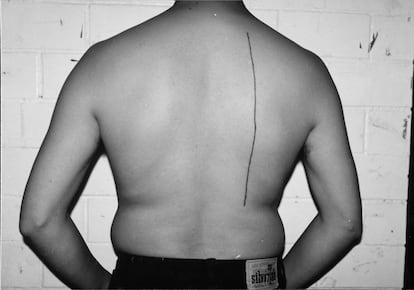
MiróMatisse. Beyond the images, Joan Miró Foundation
One positioned himself as one of the main exponents of surrealism, the other, of favism, two apparently different pictorial conceptions. But Joan Miró (1893-1983) and Henri Matisse (1869-1954), mutual admirers, were great friends and had deep relationships, not only on a personal level, but also on an artistic level. The exhibition, curated by Rémi Labrusse, decides to focus on the moments in which the exchanged gazes of both were particularly productive. An exhibition that follows the careers of the two artists chronologically and that aims, as the curator explained, to show more than the influence of one on the other, the “reciprocal stimuli” between them. A tour with more than 160 works from museums such as the MoMa in New York, or the Reina Sofía in Madrid, in addition to contributions from the families of both. Until February 9.
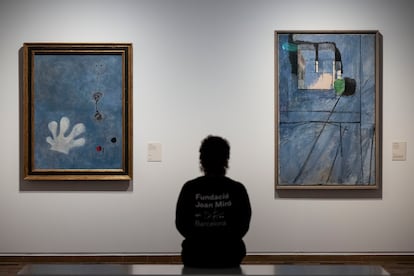
Gabriele Münter. The great expressionist painter, Thyssen-Bornemisza National Museum
From that legendary artistic movement called Der Blaue Reiter (The Blue Horseman) names such as Wassily Kandinsky, Franz Marc or Paul Klee are usually remembered. But on the walls that displayed the works of the famous expressionist group, which emerged in Munich in 1911, there was also that of a woman: Gabriele Münter (1877-1962). Although very recognized in her native country, Germany, and successful in her time, her name has remained distant from the general Spanish public and a good part of the European public. The Madrid art gallery, 113 years after the emergence of the expressionist movement in Germany, presents the artist to Spain with its first retrospective in the country – curated by Marta Ruiz del Arbol, Isabelle Jansen and Matthias Mühling – and the most extensive outside of Germany —more than 140 paintings, drawings, engravings and photographs. After passing through Madrid, the exhibition will travel to the Museum of Modern Art in Paris. Until February 9.
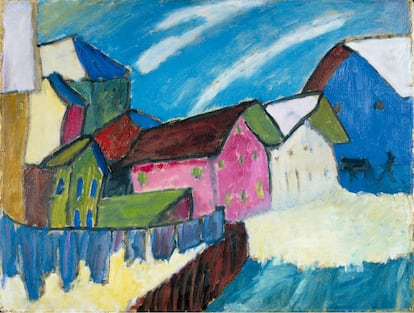
Rubens’ workshopPrado Museum
Pedro Pablo Rubens (1577-1640) was one of the most successful and prolific painters of his time. Thanks to his workshop (also called a workshop), from which more than 2,000 paintings came out, he was able to market his art on a large scale and obtain an economic benefit like very few artists of his time. Young artists from all over Europe worked and trained in his workshop. The Prado Museum reconstructs that space, between the smell of turpentine and painting tools, exhibiting more than thirty works from the Flemish artist’s factory in one of the rooms of the Villanueva building. Some of them carried out by the teacher, others by the assistants and many others, the result of collaboration in different degrees between these and that. An exhibition that aims, as explained by its curator, Alejandro Vergara, the head of Conservation of the Flemish Painting area of the Prado in the presentation, to show how the European painters of the time worked in the workshops, through the most prolific of them. Until February 16.
